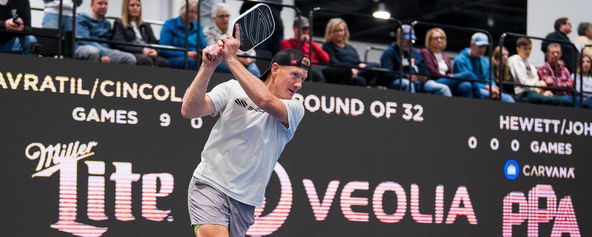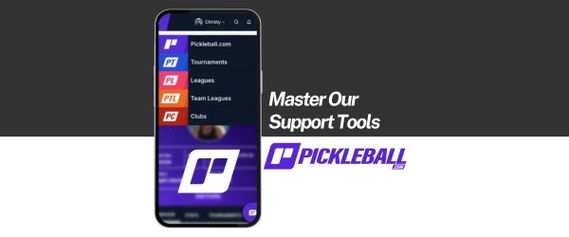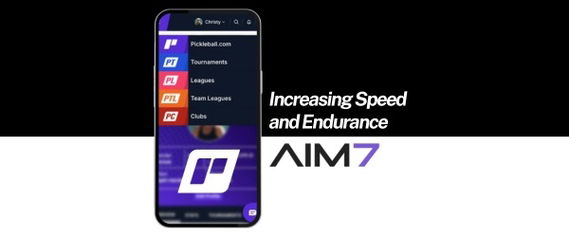
A Deep Dive Into the Rules of Pickleball
It’s no secret that pickleball has experienced major growth in recent years.
People from all walks of life are flocking to their local courts and signing up for tournaments to showcase their skills.
Even athletes from other professional sports are getting in on the fun.
Excited to join America’s fastest-growing sport, but not sure where to start? Read on for all the rules you could ever want to know about pickleball.
Dimensions of a pickleball court
A pickleball court runs 44 feet by 20 feet, with a net running through the middle that measures 36 inches high on the sides and 34 inches high in the middle.

The most important part of any pickleball court is the non-volley zone, also referred to as “the kitchen.” The kitchen (the red section of the court in the above photo) is the seven-foot area on each side of the net that has important implications for the rules we’ll get into shortly. More on the “NVZ” later.
ADVERTISEMENT
Great beginnings: Understanding different types of serves
Whether you’re playing singles or doubles, each point in a pickleball match begins with a serve.
One of the biggest things to note, especially for former tennis players getting into pickleball, is that overhand serves are not allowed.
Instead, serves must be completed underhand, and there are two types of underhand serves that are acceptable in pickleball: the volley serve and the drop serve.
With a volley serve, the player tosses the ball up and hits it on the way down before it bounces.
One important rule that was added to the USA Pickleball Rulebook in 2023 is that players are not allowed to add spin to the ball when they toss it.
This serving guide from USAP provides some more valuable information on how to execute the underhand volley serve.
Here are some of the highlights:
- · The paddle must strike the ball in an upward motion.
- · Contact with the ball cannot be made above waist-level.
- · The highest part of the paddle head must be below wrist-level when striking the ball.
With a drop serve, the player drops the ball from whatever height and waits until after it bounces to hit it. It’s important to note, though, that the player must simply drop, not throw, the ball down when doing a drop serve. No force other than gravity can impact dropping the ball.
Pro pickleball coach Mark Renneson explains some of the nuances of and differences between these two serves in this video from Selkirk TV.
Where to serve from and where to aim
Each player must serve from behind their own baseline, on one side of the center line that divides their side of the court down the middle. When making contact with the ball, the server’s feet cannot be inside the court or touching the baseline, but it is acceptable to step into the court for a follow-through once contact with the ball has been made.
Additionally, players must serve crosscourt from where they are positioned. If they serve from the right side, then the serve must land on the left side of the court on the other side of the net.
Each serve has to be deep enough, though, to make sure that it doesn’t touch any part of that aforementioned non-volley zone on their opponent’s side of the net. If it touches that zone, even just the kitchen line, then the serve is no good.
Twice as nice: Pickleball’s two-bounce rule and double-bounce rule
Even though both of these rules are based on the number two, they refer to different parts of the sport.
According to the two-bounce rule, the ball must bounce once on each side of the court after being served. Here’s the beginning sequence of a point following the two-bounce rule:
- 1. Serve
- 2. Ball bounces on opponent’s side
- 3. Opponent returns the serve over the net
- 4. Ball bounces on the serving team’s side
- 5. Point continues
After the two bounces in this point, each team is allowed to volley as the point continues. This rule prevents players from executing the serve-and-volley, a technique common in tennis where players rush the net after a serve for an easy put away on the third shot.
Pickleball’s two-bounce rule gives the returning team the advantage because it allows them to get to the kitchen first and have a better shot at stopping the serving team from scoring points.
The double-bounce rule, on the other hand, is the same rule from tennis. If the ball bounces two times on the same side of the net during a point, then the ball is immediately ruled dead and the point ends. Naturally, the team that let the ball bounce twice loses the point.
Check out this article from Paddletek for more information on the difference between these two rules.
The golden rule of pickleball: No volleys in the kitchen
The kitchen, or non-volley zone, is that 7-foot space on each side of the net (see the picture above).
Players are not allowed to hit volleys (hit shots before they bounce) while standing in the kitchen. Players are also prohibited from going into the kitchen even if their momentum pushes them in right after hitting a volley (this even includes their paddles on a low volley).
These rules help ensure that players don’t just stand right at the net, smashing each ball that comes their way.
Even though players can’t volley in the kitchen, they can play in the kitchen as much as they want, as long as they let the ball bounce before hitting it.
In fact, most doubles games are won and lost by the level of play at the kitchen line.
That’s where shots like dinks, counters and resets come into play, but we’ll explore those in another article.
So… what now?
After a painstaking examination of some of the fundamental rules of pickleball, there are just a few remaining steps to take before you’re ready for your first game.
At the very least, you’ll need a paddle, balls and shoes, and maybe even some new clothes, too.
It sounds like a lot, but Pickleball Central has everything to get you set up.
Check it out, and I’ll see you on the court.
Related articles

Five game-changing tips to elevate your pickleball skills
Learn from one of the best coaching minds in the business, John Cincola.
16 hours ago
-Victoria Radnothy
.jpg?width=592&height=237&optimizer=image)
Post-Pickleball Cooldown Routines: Science Proven Methods
2 days ago
-Guest Author

Mastering Our Support Tools
2 days ago
-Tyrece Warner

Pickleball Conditioning: Proven Exercises to Increase Speed and Boost Endurance
2 days ago
-Guest Author





